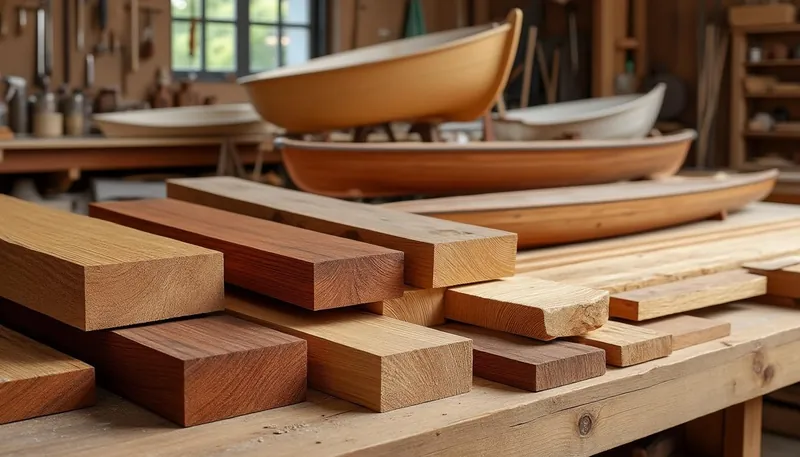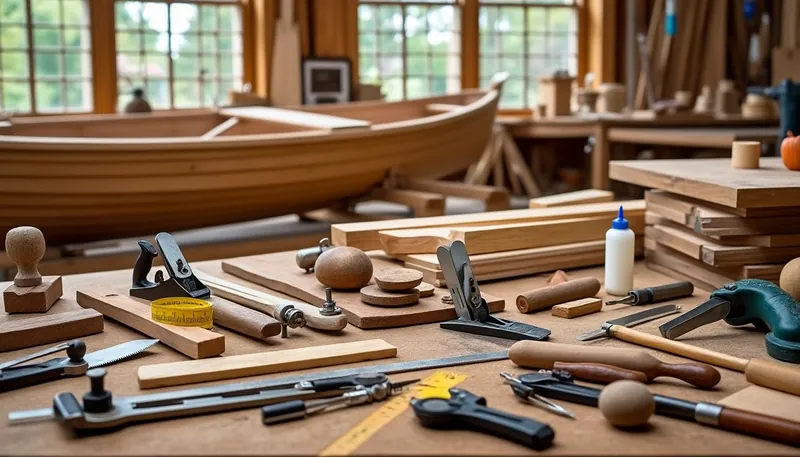Building a wooden boat from scratch is a rewarding journey that combines craftsmanship, patience, and a love for the water. Whether you’re revitalizing a childhood dream of sailing on peaceful lakes or testing the waves of the open sea, the process is both challenging and fulfilling. From selecting the right type of wood to assembling intricate parts, each step contributes to creating a sturdy vessel that can navigate through the waters. Crafting your own boat allows for personalization, stands as a testament to your skills, and fosters a deeper connection to nautical traditions. This guide will walk you through the fundamental steps in the boat building process, making the daunting task manageable even for beginners.
Brief:
- Choose the right wood for your boat building project 🌳
- Familiarize yourself with essential tools and materials 🔧
- Understand the design of the boat and create plans 📝
- Prepare the workspace for efficient building 🏗️
- Learn about the assembly process and techniques for durability ⚓
Choosing the Right Wood for Your Boat Building Project
The first step in building a wooden boat is selecting the appropriate type of wood. The choice of timber can significantly impact the boat’s durability, weight, and overall performance. Here’s a breakdown of some commonly used types of wood in boat building:
- Cedar: Often favored for its lightweight and natural resistance to rot, cedar is an excellent choice for both hulls and decks.
- Oak: Known for its strength and sturdiness, oak is ideal for structural components requiring durability.
- Pine: Easily available and cost-effective, pine is suitable for frames and internal structures. Its lightweight nature makes it easy to handle, though it may require treatment for longevity.
- Mahogany: Highly valued for its beauty and resistance to moisture, mahogany is typically used for trim and ornaments.
Selecting the right wood is essential. For example, if you want to build a boat that will be frequently exposed to water, cedar or mahogany could be perfect choices. On the other hand, oak can be utilized creatively in high-stress areas, thanks to its toughness.
Understanding the Importance of Wood Treatment
Once you have chosen your wood, it’s imperative to treat it properly to enhance its resistance to water and decay. Here are a few treatment options:
- Sealants: Applying sealants can protect the wood from moisture absorption, making it less susceptible to rot. You can look into products specifically designed for marine applications.
- Varnish: A good quality varnish can provide a beautiful finish while protecting the wood from UV rays and water damage.
- Preservatives: Chemical preservatives can help fend off pests and fungi, prolonging the life of your boat.
This treatment is crucial; untreated wood can lead to short-lived vessels that buckle under pressure. Make sure to follow manufacturer’s instructions for applying these treatments for optimal results.
| Type of Wood | Characteristics | Best Use |
|---|---|---|
| Cedar | Lightweight, resistant to rot | Hulls and decks |
| Oak | Very strong, durable | Structural components |
| Pine | Cost-effective, lightweight | Frames and internal structures |
| Mahogany | Beautiful, moisture-resistant | Trim and decorative features |
Familiarizing Yourself with Essential Tools and Materials
Embarking on the journey of building a wooden boat means acquiring the right tools. Each tool plays a vital role in ensuring the efficiency and precision of your work. Here’s a rundown of critical tools you’ll need:
- Hand saws: Ideal for cutting timber according to your plans.
- Router: Essential for shaping edges and creating smooth curves.
- Sanders: For fine finishing to prevent splinters and enhance appearance.
- Clamps: To secure pieces together as adhesives cure or screws are tightened.
- Drills: Required for making holes for screws, which are essential for stability.
In addition to traditional tools, you might want to consider investing in modern technologies such as laser cutters for precise dimensions. Remember, maintaining your tools is also crucial; a dull blade can lead to rough cuts, which can weaken the overall structure.
Materials Beyond Tools
Understanding the materials you’ll use is equally important. Here’s a list of materials commonly used in boat building:
- Epoxy resin: A key component in bonding wood and ensuring water resistance.
- Fiberglass cloth: Often used for additional strength over hull joints and other vulnerable areas.
- Wood screws and nails: Necessary for securing various wooden components together.
- Fiberglass and Marine-Grade Paints: Either can help protect the boat from elements and provide a clean finish.
Having the correct materials on hand not only streamlines the building process but also adds to the longevity and strength of your boat.
Understanding the Design and Creating Plans
Before you start firing up those power tools, an essential step is understanding your boat’s design and creating robust plans. The design affects everything from the boat’s aesthetic appeal to its navigational capabilities.
- Determine the Purpose: Will you be using this boat for fishing, leisure, or perhaps racing? The purpose defines many design elements.
- Consider Size: Assess how many passengers you want to accommodate and how much gear you’ll be bringing aboard.
- Research Existing Designs: Look into designs from resources like TimberCraft Boats or Nautical Knot Workshop for inspiration and structural integrity.
- Create Detailed Blueprints: Use design software or classic graph paper to draw your plans, detailing measurements, sections, and connections.
Investing time in the design phase pays off as it directly reflects your boat’s performance on the water.
| Design Element | Considerations |
|---|---|
| Purpose | Fishing, leisure, racing |
| Size | Capacity for people and gear |
| Left or Right Handed? | Customize for ease of handling |
| Hull Shape | Stability, speed, maneuverability |
Preparing the Workspace for Efficient Building
Creating an efficient workspace is paramount for smooth sailing throughout the boat-building process. Ensure that your workspace is organized and set up for safety and efficiency. Here are key tips to prepare your area:
- Location: Choose an area that’s spacious, preferably indoors or under a shelter to protect materials from the weather.
- Organization: Keep tools and materials together, ensuring quick access during cutting, sanding, and assembly.
- Safety Gear: Always wear safety glasses, gloves, and masks to protect your eyes and lungs from dust and debris.
- Lighting: Ensure adequate lighting; poor visibility can lead to mistakes and accidents.
Having a well-prepared workspace can considerably enhance your efficiency. It is easy to overlook, but the organization can save you valuable time and energy.
Creating a Workflow Plan
Establishing a workflow assists in staying on track. Here’s how to create an effective workflow plan:
- Step-by-Step Process: Define the order of operations, including cutting, assembling, and applying finishes.
- Set Deadlines: Assign realistic timelines to each task for better time management.
- Review Progress: Regularly monitor your progress; if something isn’t working, adjust your approach.
This systematic approach can take the overwhelm out of the project, ensuring that you’re advancing steadily from start to finish.
Learning About the Assembly Process and Techniques for Durability
Once all the pieces are prepared and you have your workspace set up, it’s time to start assembling your boat. The assembly process involves various techniques designed to maximize the strength and durability of your boat:
- Joinery Techniques: Familiarize yourself with techniques like mortise and tenon or lap joints to ensure robust connections between wood pieces.
- Fastening Methods: Use appropriate screws, nails, and adhesives that are resistant to water and rot.
- Weight Distribution: Ensure even weight distribution to maximize stability on water.
- Finishing Touches: Apply varnish or paint to the exterior after assembly to ensure protection against elements.
Effective assembly does not just bolster aesthetics but also enhances the vessel’s seaworthiness.
| Assembly Technique | Purpose | Materials Needed |
|---|---|---|
| Mortise and Tenon | Sturdy joints for frame structure | Wood, chisel, clamps |
| Lap Joints | Strengthen hull connections | Wood, epoxy, screws |
| Fiberglass Reinforcement | Increase strength of joints | Epoxy resin, fiberglass cloth |
| Finishing Layers | Protect against water and UV damage | Varnish or marine-grade paint |
What types of wood are best for building a wooden boat?
Cedar, oak, and mahogany are popular choices due to their durability and resistance to rot.
How long does it take to build a wooden boat?
The timeline varies based on complexity, size, and your craftsmanship level, ranging from several weeks to months.
Do I need any special permissions to build a boat?
Generally, you do not need special permissions for small, personal boats, but check local regulations regarding waterways.
Are there any safety tips I should follow during boat construction?
Always wear protective gear, ensure proper ventilation, and work in a safe environment to prevent accidents.
Can I use recycled wood for my boat?
Yes, recycled wood can be used, but ensure it is treated and free from pests or rot.

